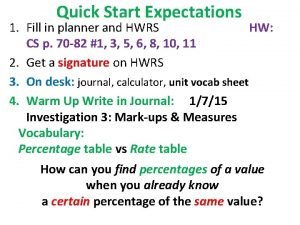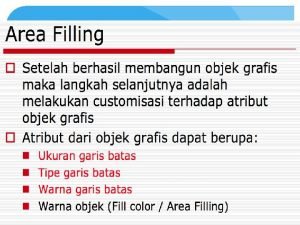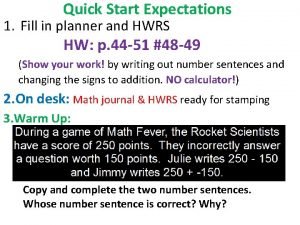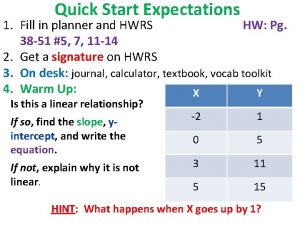Quick Start Expectations Fill in planner and HWRS













- Slides: 13

Quick Start Expectations Fill in planner and HWRS HW: MSA p. 16 -26 #3 -5 2. Get a signature on HWRS 3. On desk: journal, calculator, pencil 4. Warm Up: 1. Christine walks 1. 5 meters per second. a) How long would it take her to walk 300 meters? b) Write an equation to represent the distance d in meters that Christine could walk in t seconds if she maintained that pace. c) How far would she walk in 75 seconds? Focus Questions: • How can you predict whether a relationship is linear from a table, a graph, or an equation that represents the relationship?

Pg. 10, A -C Labsheet 1. 2


The walking rate is the amount that the distance (in meters) for each person is changing as time increases by 1 second. Alana’s walking rate is 1 m/sec. As time increases by 1 second, the distance increases by 1 meter.

What is the starting point for each student? This is called the y-intercept. What is the rate of change for each student? This is called the slope. What does the point (6, 12) represent? Whose line is it on? Whose line are these points on? (9, 9) (5, 12. 5) The greater the walking rate, the steeper the line on the graph. (or greater slope)

Alana: d = t or y = 1 x + 0 or y = x Gilberto: d = 2 t or y = 2 x + 0 or y = 2 x Leanne: d = 2. 5 t or y = 2. 5 x + 0 or y = 2. 5 x The walking rate is represented as the number that time is multiplied by to get the distance. This is the number in front of the variable. It is called the coefficient.

In the table, for every increase of 1 unit in x, the value of y increases by a constant amount. Each equation is of the form y = mx Which represents a proportional realtionship. The graph of a proportional relationship is a straight line that passes through the origin.

All three relationships between distance walked and time are proportional. They are all of the form d = rt The value of r is the constant of proportionality for each relationship. (slope)

Alana: increases by 1 m Gilberto: increases by 2 m Leanne: increases by 2. 5 m In the table it is found as the difference between the values for distance. In the graph it is the steepness of the line. As x increases by 1, y goes up 1 for Alana, 2 for Gilberto, and 2. 5 for Leanne.

If t increases by 5 seconds: Increases by 5 meters Increases by 10 meters Increases by 12. 5 meters In a table – As x increases by 5, find the difference in y values. In a graph – the difference in y-coordinates of two points on the line whose difference in x-coordinates is 5.

Walking rates per minute: Walking rates per hour: Alana: 60 m/min Gilberto: 120 m/min Leanne: 150 m/min Alana: 3, 600 m/min Gilberto: 7, 200 m/min Leanne: 9, 000 m/min (walking rate per sec x 60 sec) (walking rate per min x 60 min)

George = No Elizabeth = Yes! Constant rate 3 m/2 s Billie = Yes! Constant rate 2. 25 m/s Bob = No

HW: MSA Pg. 16 -17, #3 -5
 Planner quick start
Planner quick start Timomio
Timomio Quick find vs quick union
Quick find vs quick union The fan blade is speeding up. what are the signs of
The fan blade is speeding up. what are the signs of Fill expectations
Fill expectations Digital oscilloscope in proteus
Digital oscilloscope in proteus Teams quick start guide
Teams quick start guide Teams quick start guide
Teams quick start guide Perbedaan boundary fill dan flood fill
Perbedaan boundary fill dan flood fill Perbedaan boundary fill dan flood fill
Perbedaan boundary fill dan flood fill Is the process of filling image or region.
Is the process of filling image or region. Site:slidetodoc.com
Site:slidetodoc.com Jumpstart triage age
Jumpstart triage age Red winning color
Red winning color























